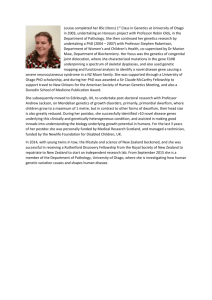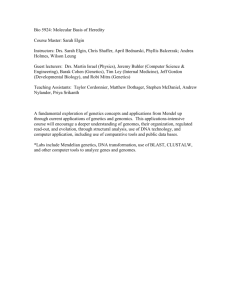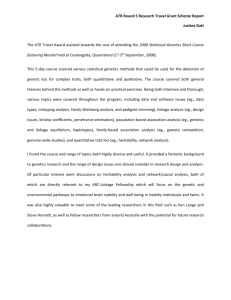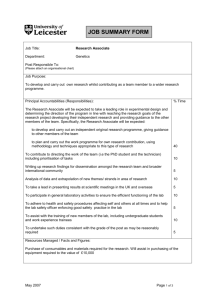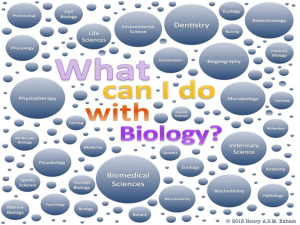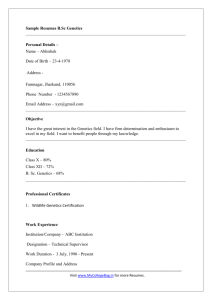The PACT™ Population Health Collaborative Face-To
advertisement
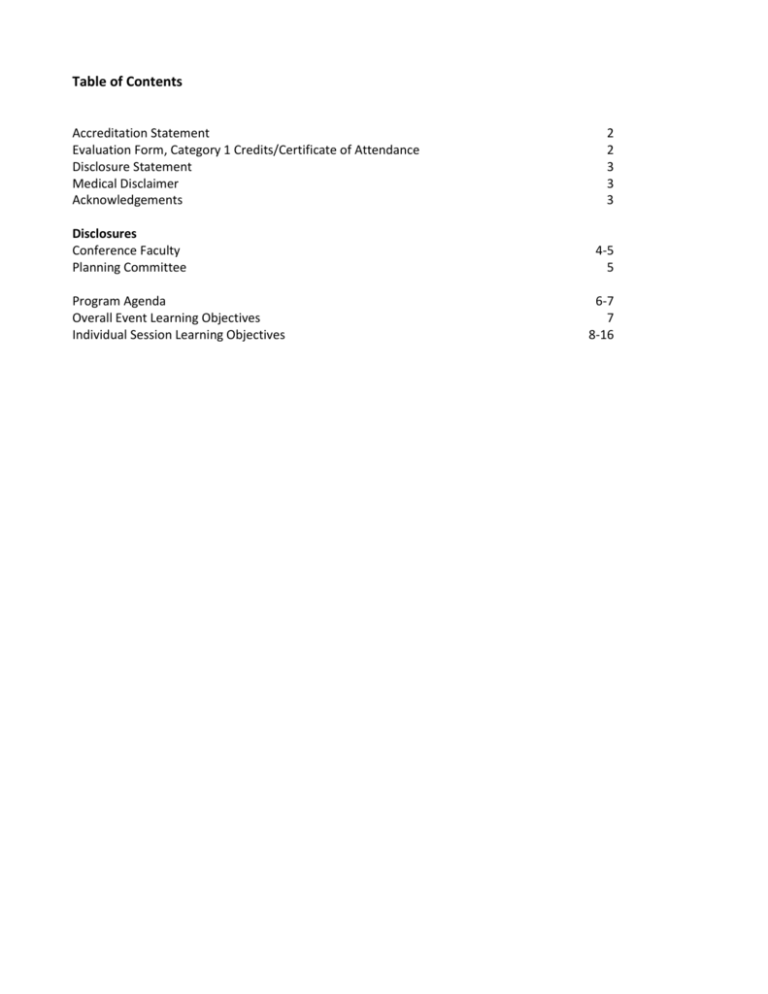
Table of Contents Accreditation Statement Evaluation Form, Category 1 Credits/Certificate of Attendance Disclosure Statement Medical Disclaimer Acknowledgements Disclosures Conference Faculty Planning Committee Program Agenda Overall Event Learning Objectives Individual Session Learning Objectives 2 2 3 3 3 4-5 5 6-7 7 8-16 Welcome to the 2014 Pauline Wilson Horner Genetics Symposium 20th Anniversary of the Center for Human Genetics From Genetics to Genomics November 7, 2014 Cleveland, OH Continuing Education: Accreditation Statement: Case Western Reserve University School of Medicine is accredited by the Accreditation Council for Continuing Medical Education to provide continuing medical education for physicians. Case Western Reserve University School of Medicine designates this live activity for a maximum of 6.75 AMA PRA Category 1 CreditsTM. Physicians should claim only the credit commensurate with the extent of their participation in the activity. Evaluation and CME Credit Certificate: The conference evaluation and CME credit certificate are available via the Internet. Once you have completed the evaluation and claimed credit commensurate with your participation in this activity, a printable certificate of credit will be available. A table to help you keep track of the sessions you attended is on the next page. The link to the evaluation and certificate is as follows: http://goo.gl/BAJV8x At the end of the evaluation, you will be automatically forwarded to the credit claim screen. If you have already registered with the Case Western Reserve University CME website, please log in using your email address and password. If you have never logged into the Case Western Reserve University CME website, enter your email address, select the “I am a new user” radio button and follow the prompts. You will need to register and go back to the “log-in” screen before you will be able to enter the CME Code. Enter the CME Code: 167631 You will be asked to enter the credits commensurate with your participation in the activity. Once you have entered those credits, a certificate will come up that you can print for your records. On the next page we have provided a table of the sessions to assist in keeping track of hours earned. Genetic Counselor CEUs: The National Society of Genetic Counselors (NSGC) has authorized Case Western Reserve University to offer up to 0.675 CEUs or 6.75 contact hours (Category 1) for the event 2014 Pauline Horner Wilson Genetics Symposium, 20th Anniversary of the Center for Human Genetics, From Genetics to Genomics. The American Board of Genetic Counseling (ABGC) will accept CEUs earned at this program for the purposes of certification and recertification. 1 Disclosure Statement: The policy of Case Western Reserve University School of Medicine CME Program (CWRU) requires that the Activity Director, planning committee members and all activity faculty (that is, anyone in a position to control the content of the education activity) disclose to the activity participants all relevant financial relationships with commercial interests. Disclosure will be made to activity participants prior to the commencement of the activity. Case Western Reserve University School of Medicine CME Program also requires that faculty make clinical recommendations based on the best available scientific evidence and that faculty identify any discussion of “off-label” or investigational use of pharmaceutical products or medical devices. The intent of this policy is not to prevent a presenter with a potential conflict of interest from making a presentation. It is the right of the audience to know about any such potential conflict of interest which should be openly identified. Members of the audience may form their own judgments and it is incumbent upon each listener to determine whether a presenter’s outside interests may reflect a possible bias in either the exposition or the conclusions presented. Detailed disclosures are made in the Faculty section of this publication. Medical Disclaimer: Medicine is an ever-changing science. As new research and clinical experience broaden our knowledge, changes in treatment and drug therapy are required. The faculty have checked with sources believed to be reliable in their efforts to provide information that is complete and generally in accord with the standards accepted at the time of publication. Although every effort is made to ensure that this material is accurate and up-to-date, it is provided for the convenience of the user and should not be considered definitive. Since medicine is an ever-changing science, neither the authors nor the Case Western Reserve School of Medicine nor any other party who has been involved in the preparation or publication of this work warrants that the information contained herein is in every respect accurate or complete, and they are not responsible for any errors or omissions or for the results obtained from the use of such information. Readers are encouraged to confirm the information contained herein with other sources. This information should not be construed as personal medical advice and is not intended to replace medical advice offered by physicians. The Case School of Medicine will not be liable for any direct, indirect, consequential, special, exemplary, or other damages arising therefrom. Acknowledgement: This program is presented by the Center for Human Genetics of University Hospitals Case Medical Center and Case Western Reserve University, and funded by a generous grant from the Marguerite M. Wilson Foundation. 2 Conference Faculty Susanne B. Cassidy, MD Professor Division of Medical Genetics Department of Pediatrics University of California, San Francisco Dr. Cassidy reported no financial relationship with a commercial interest relevant to this activity. Presentation will include discussion of unlabeled/investigational uses of a commercial product. Charis Eng, MD, PhD ACS and Hardis Professor and Chairperson, Genomic Medicine Institute, Director, Center for Personalized Genetic Healthcare Cleveland Clinic Professor and Vice Chair, Department of Genetics and Genome Sciences Case Western Reserve University School of Medicine Dr. Eng reported no financial relationship with a commercial interest relevant to this activity. Marni Falk, MD Director, Mitochondrial-Genetic Disease Clinic Children’s Hospital of Philadelphia Assistant Professor of Pediatrics, Division of Human Genetics University of Pennsylvania Perelman School of Medicine Dr. Falk reported receiving consulting fees from Mitokyne and research support from Raptor Pharmaceuticals. She is the chair of the Scientific and Medical Advisory Board and a member of the Board of Trustees for the United Mitochondrial Disease Foundation. The CME program determined there is no conflict of interest. Stacy Gabriel, PhD Director of the Genomics Platform Broad Institute of MIT and Harvard Dr. Gabriel reported no financial relationship with a commercial interest relevant to this activity. Nathaniel Robin, MD Professor of Genetics University of Alabama Dr. Robin reported no financial relationship with a commercial interest relevant to this activity. Peter Scacheri, PhD Associate Professor Department of Genetics and Genome Sciences Case Western Reserve University School of Medicine Dr. Scacheri reported no financial relationship with a commercial interest relevant to this activity. Stuart Schwartz, PhD Strategic Director of Cytogenetics Cytogenetics Laboratory Laboratory Corporation of America Dr. Schwartz reported receiving stock and salary from Laboratory Corporation of America. The CME program determined there is no conflict of interest. 3 Georgia Wiesner, MD Director, Clinical and Translational Hereditary Cancer Program Professor of Medicine Vanderbilt University Dr. Wiesner reported no financial relationship with a commercial interest relevant to this activity. Planning Committee Suzanne DeBrosse, MD, Co-Chair Clinical Assistant Professor of Genetics and Genome Sciences, Pediatrics, and Neurology Dr. DeBrosse reported no financial relationship with a commercial interest relevant to this activity. Aditi Shah Parikh, MD, Co-Chair Clinical Assistant Professor of Genetics and Genome Sciences and Pediatrics Dr. Parikh reported no financial relationship with a commercial interest relevant to this activity. Leslie Cohen, MS, PhD Licensed Genetic Counselor Clinical Instructor, Department of Genetics and Genome Sciences Dr. Cohen reported no financial relationship with a commercial interest relevant to this activity. Audrey Lynn, PhD Adjunct instructor, Department of Biology Clinical Research Specialist Dr. Lynn reported no financial relationship with a commercial interest relevant to this activity. Shawn McCandless, MD Director, Center for Human Genetics Associate Professor of Genetics and Genome Sciences and Pediatrics Dr. McCandless reported no financial relationship with a commercial interest relevant to this activity. Anna Mitchell, MD, PhD Assistant Professor of Genetics and Genome Sciences and Pediatrics Dr. Mitchell reported no financial relationship with a commercial interest relevant to this activity. Anthony Wynshaw-Boris, MD, PhD Chair, Department of Genetics and Genome Sciences James H. Jewell, MD, Professor of Genetics Dr. Wynshaw-Boris reported no financial relationship with a commercial interest relevant to this activity. 4 Program Agenda 2014 Pauline Wilson Horner Genetics Symposium 20th Anniversary of the Center for Human Genetics From Genetics to Genomics November 7, 2014 Cleveland, OH 7:30-8:30 a.m. Wolstein Lobby BREAKFAST BUFFET 8:30-8:45 a.m. Wolstein Auditorium 1413 WELCOME Anthony Wynshaw-Boris, MD, PhD Shawn McCandless, MD 8:45-9:30 a.m. Prader-Willi Syndrome, an International Perspective: Diagnosis Makes All the Difference Suzanne Cassidy, MD 9:30-10:15 a.m. PTEN-informed risk assessment and management Charis Eng, MD, PhD 10:15-10:30 a.m. BREAK 10:30- 11:15 a.m. Mitochondrial Disease Sequence Data Resource (MSeqDR) Marni Falk, MD 11:15-12 p.m. Enhancer Elements: The next frontier of diagnostics Peter Scacheri, PhD 12 p.m. Wolstein Lobby LUNCH 1-1:45 p.m. Studying Common, Rare and Somatic Variation in the Human Genome at Scale Stacey Gabriel, PhD 1:45-2:30 p.m. A Dysmorphologist in the Genomics Era Nathaniel Robin, MD 2:30-2:45 BREAK 2:45-3:30 p.m. The Changing Landscape of Cancer Genetics Georgia Wiesner, MD 3:30-4:15 p.m. The Evolution of Cytogenetics: The Beginning of the End or the End of the Beginning Stuart Schwartz, PhD 4:15- 5p.m. Panel Discussion 5 5 p.m. CLOSING COMMENTS Overall Event Learning Objectives After attending this program, participants will be able to: 1. Identify the current technological capabilities of genomic analysis 2. Integrate information about new genetic technology into clinical practice 3. Recognize the role that DNA variants play in human disease 6 Individual Session Learning Objectives Presentation Title: Prader-Willi Syndrome, an International Perspective: Diagnosis Makes All the Difference Suzanne Cassidy, MD , Professor, Division of Medical Genetics, Department of Pediatrics, University of California, San Francisco Presentation Learning Objectives: 1. Recognize the clinical findings of Prader-Willi syndrome in infants and children and their natural history 2. Explain the 3 major causes of PWS and order appropriate testing 3. Appreciate the complexities of educating care providers and families in the international arena Teaching Methodologies: Presentation followed by a question and answer session. Research or support materials: None at this time. 7 Presentation Title: PTEN-Informed Risk Assessment and Management Charis Eng, MD, PhD Genomic Medicine Institute, Cleveland Clinic Department of Genetics and Genome Sciences, Case Western Reserve University Presentation Overview: Genetics can facilitate clinical diagnoses, surveillance, treatment, and prevention. Our interest lies in extending these benefits to individuals with any of a collection of difficult-to-diagnose diseases termed PTEN Hamartoma Tumor Syndrome (PHTS), conferring increased cancer risk. Subsets of Cowden syndrome (CS) and BannayanRiley-Ruvalcaba (BRRS) syndrome, that PTEN mutation positive comprise the largest proportion of PHTS. Prior to 2011, there are no existing criteria based on large prospective patient cohorts to select patients for PTEN mutation testing, on a clinical basis. To address these issues, we conducted a multi-center prospective cohort study, where 3,042 probands minimally met relaxed NCCN clinical criteria (CS and CS-like individuals) were enrolled. Germline PTEN mutation scanning was performed for all research participants. Germline pathogenic PTEN mutations were found in 290 individuals (9.5%). To evaluate clinical phenotype and PTEN genotype against protein expression, Western blotting (for expression of PTEN, P-AKT, P-MAPK1/2) was performed for a subset of this series (N=423). In order to obtain an individualized estimation of pre-test probability of germline PTEN mutation, we developed an optimized clinical practice model to identify adult and pediatric patients. For adults, a semi-quantitative score, called the PTEN Cleveland Clinic (CC) score, resulted in a well-calibrated estimation of pre-test probability of PTEN status. Overall, decreased PTEN protein expression correlated with PTEN mutation status. Decreasing PTEN protein expression correlated with increasing CC score (p<0.001) but not with the NCCN criteria (p=0.11). For pediatric patients, we identified highly sensitive criteria to guide offering PTEN testing, with phenotypic features distinct from the adult setting. Our practice model-based improved sensitivity and positive predictive value for germline PTEN mutation relative to the NCCN 2010 criteria. We present the first evidence-based clinical practice model to select patients for genetics referral and PTEN mutation testing, which is additionally supported biologically by protein correlation. PTEN mutation negative CS and CS-like individuals still comprise the majority of such patients. Approximately 10% of PTEN mutation negative patients (0/700 controls) were found and validated to have germline SDHB-D variants, which seem to have a higher breast cancer prevalence than those with PTEN mutations. Another 35% of PTEN mutation negative CS/CS-like patients (but 0/50 controls) were found to carry germline hypermethylation of the KLLN promoter. KLLN and PTEN share a bidirectional promoter, whereby KILLIN is a p53 target gene and plays a role in S-phase apoptosis. Individuals with KLLN promoter hypermethylation seemed to have a higher prevalence of breast and renal cancers than those with PTEN mutations. Thus, PTEN, SDHx and KLLN must be considered with CS/CS-like presentations as gene-specific cancer risks differ which will guide different management. We also sought to formally determine component cancer risk in PHTS. Of 3399 prospectively accrued research participants, 368 were found to carry germline pathogenic PTEN mutations. Elevated SIRs were found for carcinomas of the breast (25.4, 95%C.I. 19.8-32.0), thyroid (51.1, 38.1-67.1), endometrium (42.9, 28.1-62.8), colorectum (10.3, 5.6-17.4), and kidney (30.6, 17.8-49.4), and melanoma (8.5, 4.1–15.6). Estimated lifetime risks were, respectively, 85.2% (95%C.I. 71.4%-99.1%), 35.2% (19.7%-50.7%), 28.2% (17.1%-39.3%), 9.0% (3.8%14.1%), 33.6% (10.4%–56.9%) and 6% (1.6%-9.4%). We conducted a 7-year, multi-center prospective study (2005-2012) of CS and CS-like patients, all of whom had comprehensive PTEN mutational analysis in order to determine the frequency of second primary malignant neoplasms (SMN). Of the 2912 adult patients included in our analysis, 2024 had an invasive cancer history. Germline pathogenic PTEN mutations (PTENmut+) were identified in 114 patients (5.6%). Of the 114, 46 (40%) had a SMN. Risks of SMNs compared with the general population were significantly elevated for all cancers (SIR7.74; 95%CI 5.84-10.07), and specifically for breast (SIR8.92; 95%CI 5.85-13.07), thyroid (SIR5.83; 95%CI 3.01-10.18) and endometrial (SIR14.08.07; 95%CI 7.10-27.21) SMNs. 8 Based on the risks of primary and second primary neoplasms, we propose a comprehensive multidisciplinary approach to surveillance of patients with PTEN mutations. Presentation Learning Objectives: 1. Review the basic principles of clinical cancer genetics 2. Explore the paradigm for clinical cancer genetics: PTEN-opathies 3. Analyze the data for PTEN-informed cancer and non-cancer risk assessment and medical management Research or support materials: 1. 2. 3. 4. 5. 6. 7. 8. 9. Nelen MR, Padberg GW, Peeters EAJ, Lin AY, van den Helm B, Frants RR, Coulon V, Goldstein AM, van Reen MMM, Easton DF, Eeles RA, Hodgson S, Mulvihill JJ, Murday VA, Tucker MA, Mariman ECM, Starink TM, Ponder BAJ, Ropers HH, Kremer H, Longy M, Eng C. Localization of the gene for Cowden disease to 10q22-23. Nature Genet. 1996;13:114-116. Liaw D, Marsh DJ, Li J, Dahia PLM, Wang SI, Zheng Z, Bose S, Call KM, Tsou HC, Peacocke M, Eng C, Parsons R. Germline mutations of the PTEN gene in Cowden disease, an inherited breast and thyroid cancer syndrome. Nature Genet. 1997;16:64-67. Zbuk K, Eng C. Cancer phenomics: RET and PTEN as illustrative models. Nature Rev. Cancer. 2007;7:3545. Tan MH, Mester J, Peterson C, Yang Y, Chen JL, Rybicki LA, Milas K, Pederson H, Remzi B, Orloff MS, Eng C. A clinical scoring system for selection of patients for PTEN mutation testing is proposed on the basis of a prospective study of 3042 probands. Am. J. Hum. Genet. 2011;88:42-56. Tan MH, Mester JL, Ngeow J, Rybicki LA, Orloff MS, Eng C. Lifetime cancer risks in individuals with germline PTEN mutations. Clin. Cancer Res. 2012;18:400-407. Ni Y, Zbuk KM, Sadler T, Patocs A, Lobo G, Edelman E, Platzer P, Orloff MS, Waite KA, Eng C. Germline mutations and variants in the succinate dehydrogenase genes in Cowden and Cowden-like syndromes. Am. J. Hum. Genet. 2008;83:261-268. Ni Y, He X, Chen J, Moline J, Mester J, Orloff MS, Ringel MD, Eng C. Germline SDHx variants modify breast and thyroid cancer risks in Cowden and Cowden-like syndrome via FAD/NAD-dependent destabilization of p53. Hum. Mol. Genet. 2012;21:300-310. Bennett KL, Mester J, Eng C. Germline epigenetic regulation of KILLIN in Cowden and Cowden-like syndrome. JAMA. 2010;304:2724-2731. Ngeow J, Stanuch K, Mester JL, Barnholtz-Sloan J, Eng C. Second malignant neoplasms in Cowden syndrome patients with underlying germline PTEN mutations. J Clin Oncol 2014; 32:1818-24. PTEN Scoring System: http://www.lerner.ccf.org/gmi/ccscore/ Gene Reviews: PHTS http://www.ncbi.nlm.nih.gov/books/NBK1488/ Support Groups: http://www.ptenfoundation.org/ http://www.ptenworld.com/ http://ptenlife.com/ Teaching Methodologies: Presentation followed by a question and answer session. 9 Presentation Title: Mitochondrial Disease Sequence Data Resource (MSeqDR) Marni Falk, MD , Director, Mitochondrial-Genetic Disease Clinic, Children’s Hospital of Philadelphia, Assistant Professor of Pediatrics, Division of Human Genetics, University of Pennsylvania Perelman School of Medicine Presentation Overview: Mitochondrial Disease Sequence Data Resource (MSeqDR) Consortium Success rates for genomic analyses of highly heterogeneous disorders can be greatly improved if a large cohort of patient data is assembled to enhance collective capabilities for accurate sequence variant annotation, analysis, and interpretation. Indeed, molecular diagnostics requires data sharing to inform accurate understanding of gene variants and phenotypes, which requires the establishment of robust data resources. The “Mitochondrial Disease Sequence Data Resource (MSeqDR) Consortium” is a grass-roots effort facilitated by the United Mitochondrial Disease Foundation to identify and prioritize specific genomic data analysis needs of the global mitochondrial disease clinical and research community. A central Web portal (https://mseqdr.org) facilitates the coherent compilation, organization, annotation, and analysis of sequence data from both nuclear and mitochondrial genomes from individuals and families with suspected mitochondrial disease. This Web portal provides users with a flexible and expandable suite of resources to enable variant-, gene-, and exome-level sequence analysis in a secure, Web-based, and user-friendly fashion. Users can also elect to share data with other MSeqDR Consortium members or even the general public, either by custom annotation tracks or through use of a convenient distributed annotation system (DAS) mechanism. A range of data visualization and analysis tools are provided to facilitate interrogation and improve understanding of both genomic, and ultimately phenotypic, data that are relevant to mitochondrial biology and disease. Currently available tools for nuclear and mitochondrial gene analyses include an MSeqDR GBrowse instance that hosts optimized mitochondrial disease and mitochondrial DNA (mtDNA) specific annotation tracks, as well as an MSeqDR locus-specific database (LSDB) that curates variant data on more than 1,300 genes that have been implicated in mitochondrial disease and/or are known to encode mitochondrialocalized proteins. MSeqDR is integrated with a diverse array of mitochondrial genome data analysis tools that are both freestanding and incorporated into an online exome-level data set curation and analysis resource (GEM.app) that is being optimized to support needs of the MSeqDR community. In addition, MSeqDR supports mitochondrial disease phenotyping and ontology tools, and provides variant pathogenicity assessment features that enable community review and feedback as well as integration with the public ClinVar resource (http://www.ncbi.nlm.nih.gov/clinvar/). A centralized Web-based informed consent process is being developed, as well as a Global Unique Identifier (GUID) system to integrate data deposited from different sources. Community-based data deposition into MSeqDR has already begun. Future efforts will enhance capabilities to incorporate phenotypic data that enhance genomic data analyses. MSeqDR will fill the existing void in bioinformatics tools and centralized knowledge that are necessary for efficient nuclear and mtDNA genome data interpretation by a range of shareholders across both clinical and research settings. Ultimately, MSeqDR is focused on empowering the global mitochondrial disease community to better define and explore mitochondrial disease. Presentation Learning Objectives: 1. Explain background rationale and organization of MSeqDR Consortium 2. Describe the MSeqDR Prototype Development Project 3. Review MSeqDR Component overview and functionality Teaching Methodologies: Presentation followed by a question and answer session. Research or support materials: None at this time. 10 Presentation Title: Enhancer Elements: The next frontier of diagnostics. Peter Scacheri, PhD, Associate Professor, Case Western Reserve University School of Medicine Presentation Learning Objectives: 1. Recognize the importance of regulatory elements located outside protein coding genes. 2. Recognize that DNA mutations in enhancer elements can lead to human diseases 3. Recognize that many common diseases are caused by DNA variants that alter enhancer activity, leading to disruptions in gene expression. Teaching Methodologies: Presentation followed by a question and answer session. Research or support materials: None at this time. 11 Presentation Title: Studying Common, Rare and Somatic Variation in the Human Genome at Scale Stacey Gabriel, PhD, Director of the Genomics Platform, Broad Institute of MIT and Harvard Presentation Learning Objectives: 1. Discuss current technological capabilities of genomic analysis 2. Explain the impact of genomic analysis on our understanding of the architecture of human variation 3. Discuss successes and challenges of whole exome sequencing in common disease and cancer Teaching Methodologies: Presentation followed by a question and answer session. Research or support materials: None at this time. 12 Presentation Title: A Dysmorphologist in the Genomics Era Nathaniel Robin, MD, Professor of Genetics, University of Alabama Presentation Learning Objectives: 1. Identify the indications for and benefits of making a genetic diagnosis 2. Describe the process of a genetics evaluation, with specific attention to assessment of minor anomalies (dysmorphology) 3. Review the role of various types of genetic testing, and speculate on the impact of new technologies Teaching Methodologies: Presentation followed by a question and answer session. Research or support materials: None at this time. 13 Presentation Title: The Changing Landscape of Cancer Genetics Georgia Wiesner, MD, Director, Clinical and Translational Hereditary Cancer Program, Professor of Medicine Vanderbilt University Presentation Learning Objectives: 1. List the principles of clinical cancer genetics 2. Recognize the differences between acquired and constitutional mutations in cancer 3. Discuss the use of next generation sequencing panels for cancer genetics diagnostics 4. Explore new paradigms for identifying patients at risk for cancer. Teaching Methodologies: Presentation followed by a question and answer session. Research or support materials: None at this time. 14 Presentation Title: The Evolution of Cytogenetics: The Beginning of the End or The End of the Beginning Stuart Schwartz, PhD, Strategic Director of Cytogenetics, Cytogenetics Laboratory, Laboratory Corporation of America Presentation overview: Cytogenetic analysis has evolved over the past 6 years and microarray analysis has become routinely integrated, as a standard protocol, for pediatric patients referred with anomalies and/or developmental delay. The purpose of a presentation is to highlight the basic technology, methodology and analysis underlying the SNP genotyping array and to discuss it application to clinical practice. These studies demonstrate both the effectiveness and efficacy of utilizing array analysis for the study of genetic abnormalities, including not only copy number changes, but also uniparental disomy and consanguinity. Additionally the future of genetic testing in pediatrics will be examined to look at its possible continue evolution. Presentation Learning Objectives: 1. Explain the technology underlying SNP array analysis, to realize the importance in delineating small copy number changes and to appreciate how the diagnosis of pediatric genetic disease will continue to evolve. 2. Describe how array technology can detect both UPD and consanguinity and the importance of these findings in clinical practice 3. Recognize the new microdeletion/duplication syndromes that have been delineated due to array technology. To appreciate, based on the insight provided by SNP arrays, that in many instances chromosome abnormalities are more complex than they have appeared to be based solely on cytogenetic analysis. Teaching Methodologies: Presentation followed by a question and answer session. Research or support materials: None at this time. 15 Friday, November 7th Time 8:45 – 9:30 am 9:30 – 10:15 am 10:15 – 10:30 am 10:30 – 11:15 am 11:15 am – 12:00 pm 12:00 – 1:00 pm 1:00 – 1:45 pm 1:45 – 2:30 pm 2:30 – 2:45 pm 2:45 – 3:30 pm 2014 Pauline Wilson Horner Genetics Symposium, From Genetics to Genomics Prader-Willi Syndrome, an International Perspective: Diagnosis Makes All the Difference Suzanne Cassidy, MD PTEN-Informed Risk Assessment and Management Charis Eng, MD, PhD BREAK Mitochondrial Disease Sequence Data Resource (MSeqDR) Marni Falk, MD Enhancer Elements: The Next Frontier of Diagnostics Peter Scacheri, PhD LUNCH Studying Common, Rare and Somatic Variation in the Human Genome at Scale Stacey Gabriel, PhD A Dysmorphologist in the Genomics Era Nathaniel Robin, MD BREAK 3:30 – 4:15 pm The Changing Landscape of Cancer Genetics Georgia Wiesner, MD The Evolution of Cytogenetics: The Beginning of the End or the End of the Beginning Stuart Schwartz, PhD 4:15 – 5 pm Panel Discussion TOTAL CREDITS Credits .75 .75 .75 .75 .75 .75 .75 .75 .75 6.75 16

